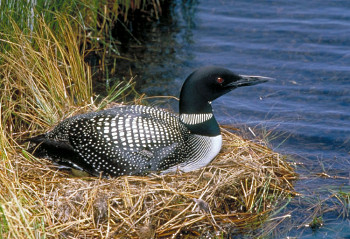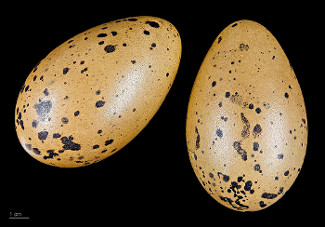Common Loon
- Nesting and Breeding -

Territory
Common Loons return to their breeding lakes as soon as the ice melts in the early spring. The size of their territory is typically 60 to 200 acres, although it can be larger or smaller.
Loons are easily disturbed during the nesting season and prefer to nest on lakes where there is little human activity. If there is too much disturbance, loons may abandon their nest.
On its breeding ground, the Common Loon is highly territorial. Its defensive behavior increases during the nesting period and peaks in the first weeks after the chicks hatch.
These birds are thought to mate for life and often use the same nest site year after year.
Nest
The Common Loon nests as close to the water as possible. Islands, which provide protection from predators, are the preferred nest location.
Both sexes build the bulky nest, which consists of twigs, grasses, reeds, and other aquatic vegetation. Some sources indicate that the eggs are laid directly in a depression in the mud and the nest materials are collected after incubation begins.
Copyright: Nature of New England. All rights reserved.
Incubation and Fledging
The Common Loon typically lays two eggs, but occasionally only one. The eggs are olive-brown to olive-green with scattered dark spots or blotches.
Both parents incubate the eggs, which hatch in about 28 to 30 days. The chicks leave the nest within 24 hours of hatching. At this point, they can swim but usually spend some time riding on their parents' backs during the first couple of weeks. This may help the chicks keep warm and protect them from predators.
For the first 8 weeks or so, the young loons are fed by their parents. Over the following weeks, they gradually learn to dive well enough to obtain their own food. By three months of age or sooner, they are able to fly and become independent of their parents.
Common Loon Eggs

By Muséum de Toulouse [CC SA 4.0]